Santosh Pandey
Concorde: Fast and Accurate CPU Performance Modeling with Compositional Analytical-ML Fusion
Mar 29, 2025Abstract:Cycle-level simulators such as gem5 are widely used in microarchitecture design, but they are prohibitively slow for large-scale design space explorations. We present Concorde, a new methodology for learning fast and accurate performance models of microarchitectures. Unlike existing simulators and learning approaches that emulate each instruction, Concorde predicts the behavior of a program based on compact performance distributions that capture the impact of different microarchitectural components. It derives these performance distributions using simple analytical models that estimate bounds on performance induced by each microarchitectural component, providing a simple yet rich representation of a program's performance characteristics across a large space of microarchitectural parameters. Experiments show that Concorde is more than five orders of magnitude faster than a reference cycle-level simulator, with about 2% average Cycles-Per-Instruction (CPI) prediction error across a range of SPEC, open-source, and proprietary benchmarks. This enables rapid design-space exploration and performance sensitivity analyses that are currently infeasible, e.g., in about an hour, we conducted a first-of-its-kind fine-grained performance attribution to different microarchitectural components across a diverse set of programs, requiring nearly 150 million CPI evaluations.
Tao: Re-Thinking DL-based Microarchitecture Simulation
Apr 16, 2024Abstract:Microarchitecture simulators are indispensable tools for microarchitecture designers to validate, estimate, and optimize new hardware that meets specific design requirements. While the quest for a fast, accurate and detailed microarchitecture simulation has been ongoing for decades, existing simulators excel and fall short at different aspects: (i) Although execution-driven simulation is accurate and detailed, it is extremely slow and requires expert-level experience to design. (ii) Trace-driven simulation reuses the execution traces in pursuit of fast simulation but faces accuracy concerns and fails to achieve significant speedup. (iii) Emerging deep learning (DL)-based simulations are remarkably fast and have acceptable accuracy but fail to provide adequate low-level microarchitectural performance metrics crucial for microarchitectural bottleneck analysis. Additionally, they introduce substantial overheads from trace regeneration and model re-training when simulating a new microarchitecture. Re-thinking the advantages and limitations of the aforementioned simulation paradigms, this paper introduces TAO that redesigns the DL-based simulation with three primary contributions: First, we propose a new training dataset design such that the subsequent simulation only needs functional trace as inputs, which can be rapidly generated and reused across microarchitectures. Second, we redesign the input features and the DL model using self-attention to support predicting various performance metrics. Third, we propose techniques to train a microarchitecture agnostic embedding layer that enables fast transfer learning between different microarchitectural configurations and reduces the re-training overhead of conventional DL-based simulators. Our extensive evaluation shows {\ours} can reduce the overall training and simulation time by 18.06x over the state-of-the-art DL-based endeavors.
* Published in POMACS and SIGMETRICS'24
An automated, high-resolution phenotypic assay for adult Brugia malayi and microfilaria
Sep 05, 2023Abstract:Brugia malayi are thread-like parasitic worms and one of the etiological agents of Lymphatic filariasis (LF). Existing anthelmintic drugs to treat LF are effective in reducing the larval microfilaria (mf) counts in human bloodstream but are less effective on adult parasites. To test potential drug candidates, we report a multi-parameter phenotypic assay based on tracking the motility of adult B. malayi and mf in vitro. For adult B. malayi, motility is characterized by the centroid velocity, path curvature, angular velocity, eccentricity, extent, and Euler Number. These parameters are evaluated in experiments with three anthelmintic drugs. For B. malayi mf, motility is extracted from the evolving body skeleton to yield positional data and bending angles at 74 key point. We achieved high-fidelity tracking of complex worm postures (self-occlusions, omega turns, body bending, and reversals) while providing a visual representation of pose estimates and behavioral attributes in both space and time scales.
Parameter extraction of Extended Floating Gate Field Effect Transistors (EGFETs): Estimating the threshold voltage, series resistance, and mobility degradation from I-V measurements
Jul 18, 2023Abstract:Extended Floating Gate Field Effect Transistors (EGFETs) are CMOS-compatible floating gate devices capable of detecting charges on their sensing area by the relative shifts in current-voltage (I-V) characteristics. The I-V shifts are generally computed by measuring the EGFET parameters in the strong inversion region of operation. This could lead to errors in estimating the device sensitivity because the simple I-V model ignores the mobility degradation and series resistance effects in EGFETs. Our goal is to model these parasitic effects and present methods to extract the key device parameters. We derive an analytical I-V model for EGFETs in the linear region of transistor operation, accounting for both the mobility degradation and series resistance effects. Based on the analytical model, three methods are presented to estimate the key parameters, namely the threshold voltage, series resistance, surface roughness parameter, low-field mobility, and effective mobility from the I-V characteristics, gate transconductance, and drain conductance. The peak transconductance method is used as a benchmark for comparing the extracted threshold voltages. Silicon-based EGFET devices are fabricated, and their I-V characteristics are measured with deionized water and three polyelectrolytes. From the I-V data, the parameter extraction methods are used to compute the values of the key parameters, and the suitability of each method is discussed. The gate transconductance methods show good agreement between the values for the key parameters, while the drain transconductance method gives lower values of the key parameters. There is scope to improve the presented methods by incorporating the effects of substrate bias and asymmetric series resistance for new extended-gate device architectures, including solution-based organic field-effect transistors.
Flexible and disposable paper- and plastic-based gel micropads for nematode handling, imaging, and chemical testing
Jun 23, 2022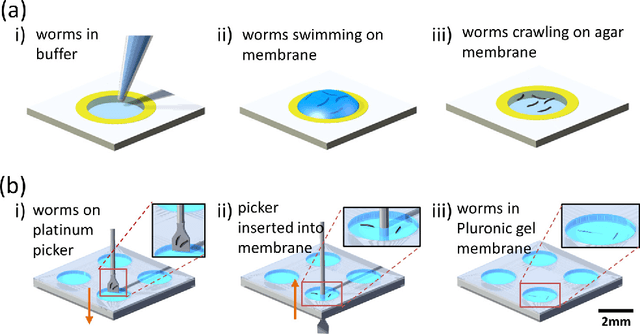
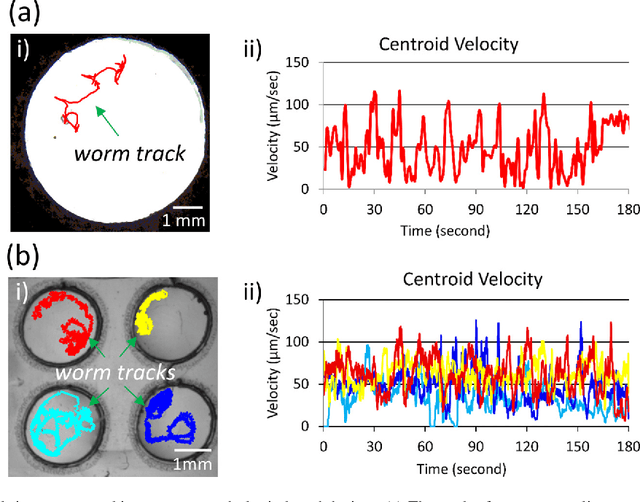

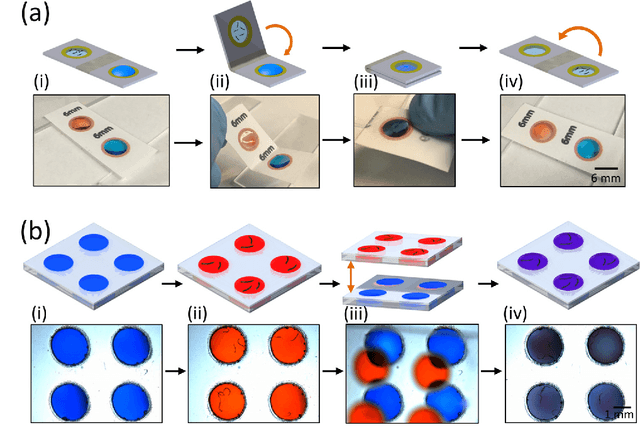
Abstract:Today, the area of point-of-care diagnostics is synonymous with paper microfluidics where cheap, disposable, and on-the-spot detection toolkits are being developed for a variety of chemical tests. In this work, we present a novel application of microfluidic paper-based analytical devices (microPADs) to study the behavior of a small model nematode, Caenorhabditis elegans. We describe schemes of microPAD fabrication on paper and plastic substrates where membranes are created in agarose and Pluronic gel. Methods are demonstrated for loading, visualizing, and transferring single and multiple nematodes. Using an anthelmintic drug, levamisole, we show that chemical testing on C. elegans is easily performed because of the open device structure. A custom program is written to automatically recognize individual worms on the microPADs and extract locomotion parameters in real-time. The combination of microPADs and the nematode tracking program provides a relatively low-cost, simple-to-fabricate imaging and screening assay (compared to standard agarose plates or polymeric microfluidic devices) for non-microfluidic, nematode laboratories.
Effective drug combination for Caenorhabditis elegans nematodes discovered by output-driven feedback system control technique
May 25, 2022Abstract:Infections from parasitic nematodes (or roundworms) contribute to a significant disease burden and productivity losses for humans and livestock. The limited number of anthelmintics (or antinematode drugs) available today to treat these infections are rapidly losing their efficacy as multidrug resistance in parasites becomes a global health challenge. We propose an engineering approach to discover an anthelmintic drug combination that is more potent at killing wild-type Caenorhabditis elegans worms than four individual drugs. In the experiment, freely swimming single worms are enclosed in microfluidic drug environments to assess the centroid velocity and track curvature of worm movements. After analyzing the behavioral data in every iteration, the feedback system control (FSC) scheme is used to predict new drug combinations to test. Through a differential evolutionary search, the winning drug combination is reached that produces minimal centroid velocity and high track curvature, while requiring each drug in less than their EC50 concentrations. The FSC approach is model-less and does not need any information on the drug pharmacology, signaling pathways, or animal biology. Toward combating multidrug resistance, the method presented here is applicable to the discovery of new potent combinations of available anthelmintics on C. elegans, parasitic nematodes, and other small model organisms.
Skin Cancer Diagnostics with an All-Inclusive Smartphone Application
May 25, 2022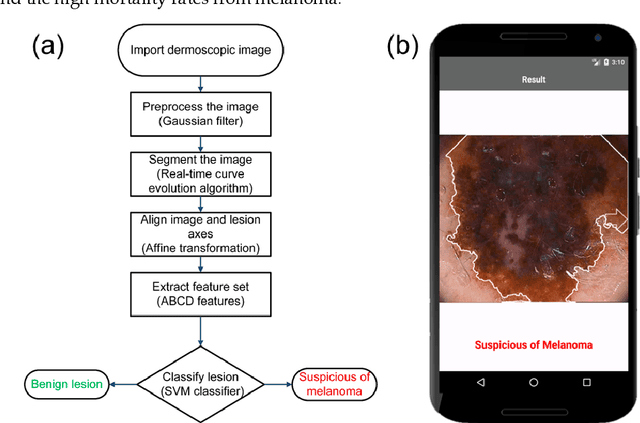
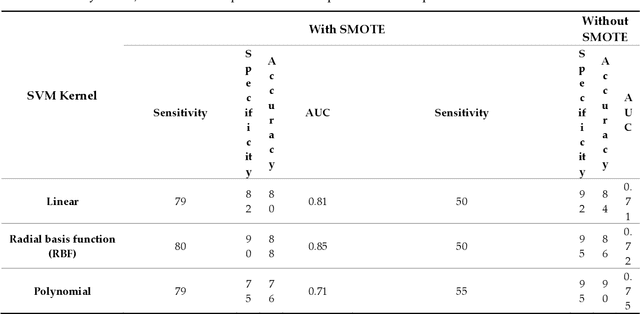
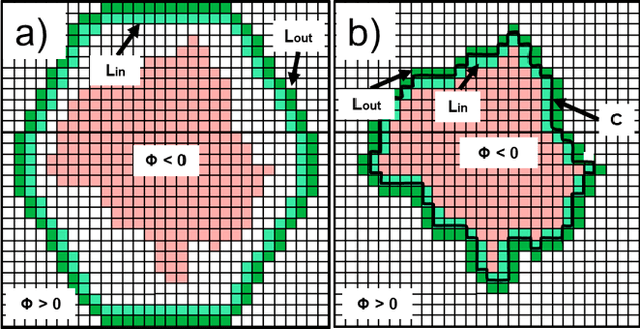

Abstract:Among the different types of skin cancer, melanoma is considered to be the deadliest and is difficult to treat at advanced stages. Detection of melanoma at earlier stages can lead to reduced mortality rates. Desktop-based computer-aided systems have been developed to assist dermatologists with early diagnosis. However, there is significant interest in developing portable, at-home melanoma diagnostic systems which can assess the risk of cancerous skin lesions. Here, we present a smartphone application that combines image capture capabilities with preprocessing and segmentation to extract the Asymmetry, Border irregularity, Color variegation, and Diameter (ABCD) features of a skin lesion. Using the feature sets, classification of malignancy is achieved through support vector machine classifiers. By using adaptive algorithms in the individual data-processing stages, our approach is made computationally light, user friendly, and reliable in discriminating melanoma cases from benign ones. Images of skin lesions are either captured with the smartphone camera or imported from public datasets. The entire process from image capture to classification runs on an Android smartphone equipped with a detachable 10x lens, and processes an image in less than a second. The overall performance metrics are evaluated on a public database of 200 images with Synthetic Minority Over-sampling Technique (SMOTE) (80% sensitivity, 90% specificity, 88% accuracy, and 0.85 area under curve (AUC)) and without SMOTE (55% sensitivity, 95% specificity, 90% accuracy, and 0.75 AUC). The evaluated performance metrics and computation times are comparable or better than previous methods. This all-inclusive smartphone application is designed to be easy-to-download and easy-to-navigate for the end user, which is imperative for the eventual democratization of such medical diagnostic systems.
New methods of removing debris and high-throughput counting of cyst nematode eggs extracted from field soil
May 25, 2022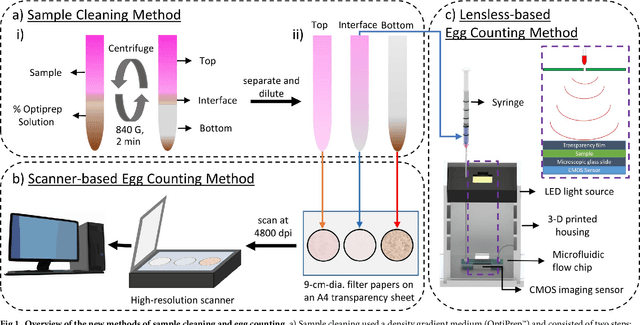
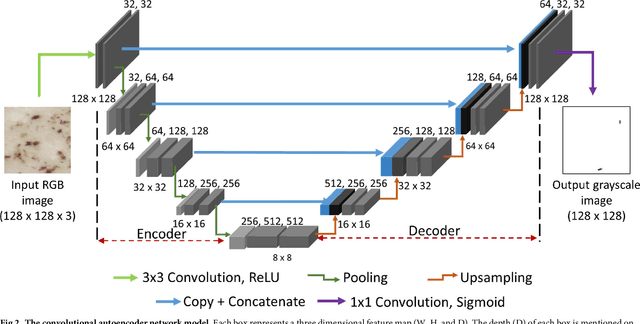
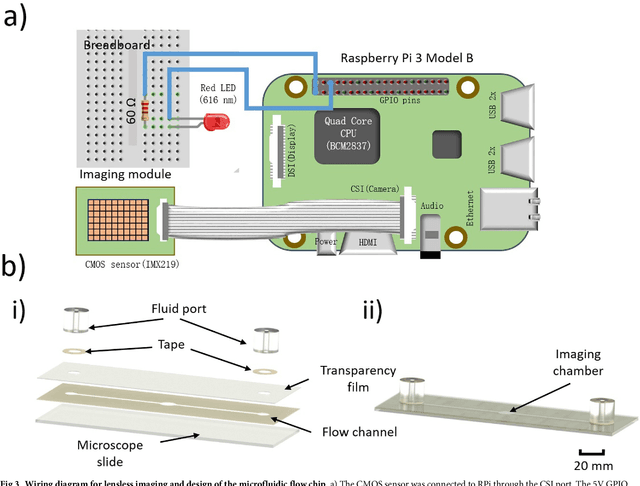
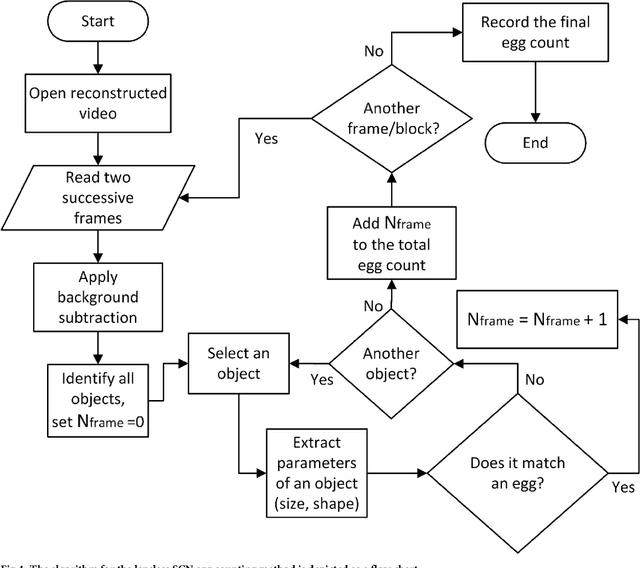
Abstract:The soybean cyst nematode (SCN), Heterodera glycines, is the most damaging pathogen of soybeans in the United States. To assess the severity of nematode infestations in the field, SCN egg population densities are determined. Cysts (dead females) of the nematode must be extracted from soil samples and then ground to extract the eggs within. Sucrose centrifugation commonly is used to separate debris from suspensions of extracted nematode eggs. We present a method using OptiPrep as a density gradient medium with improved separation and recovery of extracted eggs compared to the sucrose centrifugation technique. Also, computerized methods were developed to automate the identification and counting of nematode eggs from the processed samples. In one approach, a high-resolution scanner was used to take static images of extracted eggs and debris on filter papers, and a deep learning network was trained to identify and count the eggs among the debris. In the second approach, a lensless imaging setup was developed using off-the-shelf components, and the processed egg samples were passed through a microfluidic flow chip made from double-sided adhesive tape. Holographic videos were recorded of the passing eggs and debris, and the videos were reconstructed and processed by custom software program to obtain egg counts. The performance of the software programs for egg counting was characterized with SCN-infested soil collected from two farms, and the results using these methods were compared with those obtained through manual counting.
Robotic agricultural instrument for automated extraction of nematode cysts and eggs from soil to improve integrated pest management
May 24, 2022Abstract:Soybeans are an important crop for global food security. Every year, soybean yields are reduced by numerous soybean diseases, particularly the soybean cyst nematode (SCN). It is difficult to visually identify the presence of SCN in the field, let alone its population densities or numbers, as there are no obvious aboveground disease symptoms. The only definitive way to assess SCN population densities is to directly extract the SCN cysts from soil and then extract the eggs from cysts and count them. Extraction is typically conducted in commercial soil analysis laboratories and university plant diagnostic clinics and involves repeated steps of sieving, washing, collecting, grinding, and cleaning. Here we present a robotic instrument to reproduce and automate the functions of the conventional methods to extract nematode cysts from soil and subsequently extract eggs from the recovered nematode cysts. We incorporated mechanisms to actuate the stage system, manipulate positions of individual sieves using the gripper, recover cysts and cyst-sized objects from soil suspended in water, and grind the cysts to release their eggs. All system functions are controlled and operated by a touchscreen interface software. The performance of the robotic instrument is evaluated using soil samples infested with SCN from two farms at different locations and results were comparable to the conventional technique. Our new technology brings the benefits of automation to SCN soil diagnostics, a step towards long-term integrated pest management of this serious soybean pest.
Video Capsule Endoscopy and Ingestible Electronics: Emerging Trends in Sensors, Circuits, Materials, Telemetry, Optics, and Rapid Reading Software
May 24, 2022Abstract:Real-time monitoring of the gastrointestinal tract in a safe and comfortable manner is valuable for the diagnosis and therapy of many diseases. Within this realm, our review captures the trends in ingestible capsule systems with a focus on hardware and software technologies used for capsule endoscopy and remote patient monitoring. We introduce the structure and functions of the gastrointestinal tract, and the FDA guidelines for ingestible wireless telemetric medical devices. We survey the advanced features incorporated in ingestible capsule systems, such as microrobotics, closed-loop feedback, physiological sensing, nerve stimulation, sampling and delivery, panoramic imaging with adaptive frame rates, and rapid reading software. Examples of experimental and commercialized capsule systems are presented with descriptions of their sensors, devices, and circuits for gastrointestinal health monitoring. We also show the recent research in biocompatible materials and batteries, edible electronics, and alternative energy sources for ingestible capsule systems. The results from clinical studies are discussed for the assessment of key performance indicators related to the safety and effectiveness of ingestible capsule procedures. Lastly, the present challenges and outlook are summarized with respect to the risks to health, clinical testing and approval process, and technology adoption by patients and clinicians.
 Add to Chrome
Add to Chrome Add to Firefox
Add to Firefox Add to Edge
Add to Edge